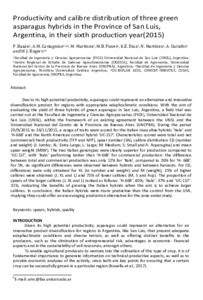Please use this identifier to cite or link to this item:
https://repositorio.uca.edu.ar/handle/123456789/9625| Título: | Productivity and calibre distribution of three green asparagus hybrids in the province of San Luis, Argentina, in their sixth production year (2015) | Autor: | Bazán, P. Castagnino, Ana María Martínez, M. Funes, M. B. Díaz, K. E. Martínez, N. Guisolis, Andrea Rogers, W. J. |
Palabras clave: | ASPARAGUS; HIBRIDOS; RENDIMIENTO DE CULTIVOS; CALIBRE | Fecha de publicación: | 2018 | Editorial: | International Society for Horticultural Science | Cita: | Bazán, P. et al. Productivity and calibre distribution of three green asparagus hybrids in the province of San Luis, Argentina, in their sixth production year (2015) [en línea]. Acta Horticulturae. 2018, 1223. doi:10.17660/ActaHortic.2018.1223.25 Disponible en: https://repositorio.uca.edu.ar/handle/123456789/9625 | Resumen: | Abstract: Due to its high potential productivity, asparagus could represent an alternative and innovative diversification product for regions with appropriate edaphoclimatic conditions. With the aim of evaluating the yield of three hybrids of green asparagus in San Luis, Argentina, a field trial was carried out at the Facultad de Ingeniería y Ciencias Agropecuarias (FICA), Universidad Nacional de San Luis (UNSL), within the framework of an existing agreement between the UNSL and the Universidad Nacional del Centro de la Provincia de Buenos Aires (UNCPBA). During the period 29/9/2015 to 26/11/2015, a range of traits were scored for the Italian masculine hybrids ‘Italo’ and ‘H-668’ and the North American control hybrid ‘UC-157’. Characteristics scored were total and net (commercial) fresh productivity (TFP and NFP), spear number (SN), calibre distribution CD (number and weight) (J: Jumbo; XL: Extra-Large; L: Large; M: Medium; S: Small and A: Asparagina) and mean spear weight (MSW). The two Italian genotypes were clearly superior for production compared to ‘UC-157’, with ‘Italo’ performing better than ‘H-668’ for commercial production: the difference between total and commercial production was only 12% for ‘Italo’, compared to 26% for ‘H-668’. For SN, no significant differences were observed between hybrids and between harvests. For CD, differences were only obtained for XL (in number and weight) and M (weight); 25% of higher calibres were obtained (J, XL and L) and 75% of lower calibres (M, S and Asp). The proportion of spears of the larger calibres (J, XL and L) ranked as follows: ‘H-668’: 40%; ‘Italo’: 37% and ‘UC-157’: 31%, indicating the benefits of growing the Italian hybrids when the aim is to achieve larger calibres. In conclusion, the Italian hybrids were more productive than the control from the USA, implying they could offer an encouraging production alternative for the zone under study. | URI: | https://repositorio.uca.edu.ar/handle/123456789/9625 | ISSN: | 0567-7572 (impreso) 2406-6168 (online) |
Disciplina: | CIENCIAS AGRARIAS | DOI: | 10.17660/ActaHortic.2018.1223.25 | Derechos: | Acceso abierto | Fuente: | Acta Horticulturae. 2018, 1223 |
| Appears in Collections: | Artículos |
Files in This Item:
| File | Description | Size | Format | |
|---|---|---|---|---|
| productivity-calibre-distribution-green.pdf | 784,74 kB | Adobe PDF |  View/Open |
Page view(s)
131
checked on Apr 30, 2024
Download(s)
175
checked on Apr 30, 2024
Google ScholarTM
Check
Altmetric
Altmetric
This item is licensed under a Creative Commons License

